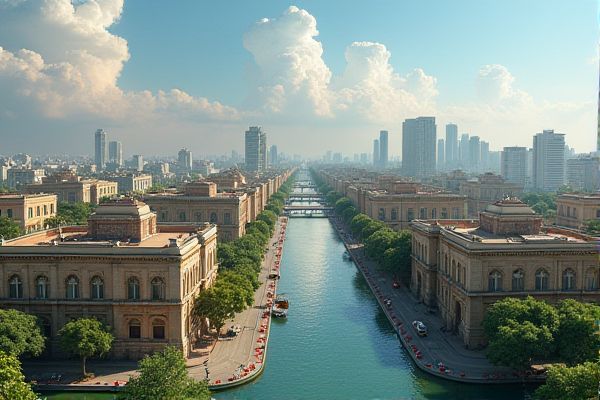
Transportation and commuting in India: Extensive train network across the country. Affordable public buses in urban areas. Auto-rickshaws are common for short distances. Ride-sharing apps like Uber and Ola available. Traffic congestion prevalent in major cities. Regional differences in transportation options. Safety varies by mode and region. Road quality can be inconsistent. Cycling increasing in urban centers. Metro systems expanding in major cities.
Extensive train network across the country.
Indian Railways operates an extensive train network, managing the fourth largest national railway system globally, with a route length of 68,584 km, over 132,310 km of total track, and more than 7,325 stations. It runs various classes of express, passenger, and suburban trains, transporting over 8.44 billion passengers and 1.418 billion tonnes of freight annually. For more information on its operations and history, visit the Indian Railways page.
Affordable public buses in urban areas.
Affordable public buses are the backbone of urban mobility in India, with over 90% of public transport in Indian cities being buses, which are cost-effective, sustainable, and easier to implement than other mass transit systems. Initiatives such as the BIG Bus Network in Bangalore and the introduction of Bus Rapid Transit (BRT) systems in cities like Indore and Bhopal aim to improve and increase the mode share of Bus Transport. These efforts reflect a commitment to enhancing public transportation infrastructure, bringing about a shift towards more efficient and environmentally friendly urban commuting solutions across the country. By investing in improved bus networks, Indian cities can fulfill the growing need for accessible and sustainable transport options.
Auto-rickshaws are common for short distances.
Auto-rickshaws are a common mode of transport in Indian cities and towns, particularly suited for short distances due to their slow speed and open carriages. They are inexpensive, environmentally friendly, and often run on CNG, LPG, or electricity, with modern versions adopting e-mobility under government initiatives. To delve deeper into the significance of this transportation method, visit the detailed entry on Auto-Rickshaw on Wikipedia.
Ride-sharing apps like Uber and Ola available.
In India, ride-sharing apps like Ola and Uber offer robust services with advanced features, including various car types, real-time GPS tracking, and dynamic pricing. Ola is more popular in India, offering a wider variety of vehicle choices and discounts, while Uber has a broader global reach and features like advance drop point entry and dynamic routing to optimize travel time. For a detailed comparison, you can explore more on the The NineHertz Blog which delves into the distinctions between these two major service providers.
Traffic congestion prevalent in major cities.
Bengaluru and Pune are among the world's most congested cities, with Bengaluru ranked as the second most congested city globally after Dublin, and Pune following closely. The average travel time for 10 km in Bengaluru was 28 minutes 10 seconds, and in Pune, it was 27 minutes 50 seconds, highlighting severe traffic congestion issues in these Indian cities. For more information, you can read about the traffic congestion rankings on the TomTom Traffic Index report.
Regional differences in transportation options.
In India, regional differences in transportation options are significant, with road transport being the primary mode nationwide, but varying greatly between urban and rural areas. Urban areas like Mumbai, Delhi, and Chennai have advanced public transport systems including metro rails, bus rapid transit systems (BRTS), and extensive bus networks. Meanwhile, rural areas rely heavily on personal vehicles, buses, and trains due to limited public transport infrastructure and geographic challenges. For more details, you can explore the comprehensive information on Transport in India.
Safety varies by mode and region.
Safety in India varies significantly by mode and region, with two-wheeler users and pedestrians being disproportionately affected, accounting for 44.8% and nearly 20% of all fatalities, respectively. Regions like Uttar Pradesh and Tamil Nadu record high numbers of road fatalities, highlighting the need for targeted interventions and improved infrastructure. For an in-depth analysis of India's road safety challenges, including the alarming crisis of over 15 lakh fatalities in a decade, visit the Financial Express for comprehensive insights.
Road quality can be inconsistent.
Road quality in India can be inconsistent, with issues such as congestion, inadequate maintenance, and safety concerns, despite the country having one of the world's largest road networks. The National Highways account for only 2% of the total road length, yet carry about 40% of the country's road traffic. The quality of India's road infrastructure is poor, with 75% of highways being only two-lane, and many roads being congested and under-maintained, while over 30% of villages lack access to all-weather roads.
Cycling increasing in urban centers.
Cycling in India's urban centers is experiencing a resurgence, driven by the COVID-19 pandemic, government initiatives like the India Cycles4Change Challenge, and a growing awareness of the environmental and health benefits of cycling, despite challenges such as poor infrastructure and traffic congestion.
Metro systems expanding in major cities.
India's Metro Rail Network has witnessed a remarkable expansion over the past decade, increasing from 248 kilometers in 5 cities to 973 kilometers in 23 cities, marking a significant milestone in urban mobility and infrastructure. With over 1,000 kilometers of metro projects currently under construction, the network aims to further enhance connectivity across the country. According to the Financial Express, India is poised to become the second-largest metro network globally, with ambitious plans to expand to about 2,000 kilometers within the next five to seven years.
